BUFFALO, N.Y. — While it's not here yet, there are promising signs that a La Niña will develop in the equatorial Pacific Ocean by mid-December.
In a seasonal update from the Climate Prediction Center, it continued and even increased its messaging in that there's now a 70 to 80 percent chance a La Niña will develop in time for the Northern Hemisphere wintertime months. It previously was a 66 percent chance in their July update.
The increased confidence comes from observed activity and trends in the equatorial Pacific Ocean where El Niños and La Niñas develop. Within the last month, the previous "ENSO-neutral" conditions have started to trend toward near-below-average, meaning cooler than average sea surface temperatures have been present (as seen in the figure below).


Those conditions would be consistent and favorable for a La Niña. Thus, the El Niño Southern Oscillation (ENSO) Alert System Status remains as a La Niña Watch.
A La Niña Watch is issued when conditions are favorable for La Niña development within the next six months. the current watch was originally issued in mid-July. This will change to a La Niña Advisory if/when conditions are present. Those conditions are at least one month with below average (cooler) sea surface temperatures in the equatorial Pacific Ocean and a noticeable, accompanying atmospheric pattern that could last for at least three months.
El Niño Southern Oscillation (ENSO) is a large, naturally occurring ocean to atmosphere phenomenon located over the equatorial Pacific Ocean. It's positive phase is an El Niño and negative phase is a La Niña. And it's closely monitored year round as it can influence weather patterns across the Northern Hemisphere, especially during the fall and winter months.
The most recent La Niña continued through the winter and even spring. Its influence wasn't as strong because it slowly weakened through those months. It was eventually deemed to have ended in late May of 2021. It's too early to tell, but the potential La Niña for this coming winter could be near equal strength.


In a La Niña wintertime pattern, the polar jet stream tends to dip farther south across the continental United States. The results of this jet stream pattern varies by location. For the Great Lakes, this typically means a wetter and colder winter. The Southeast, a warmer and drier winter. Pacific Northwest, wetter, and Southwest, drier. But it's too early to tell if this will be the case for the 2021-2022 winter season. Even so, it's never a guarantee for Buffalos' winter as the lakes have a heavy influence locally too.


